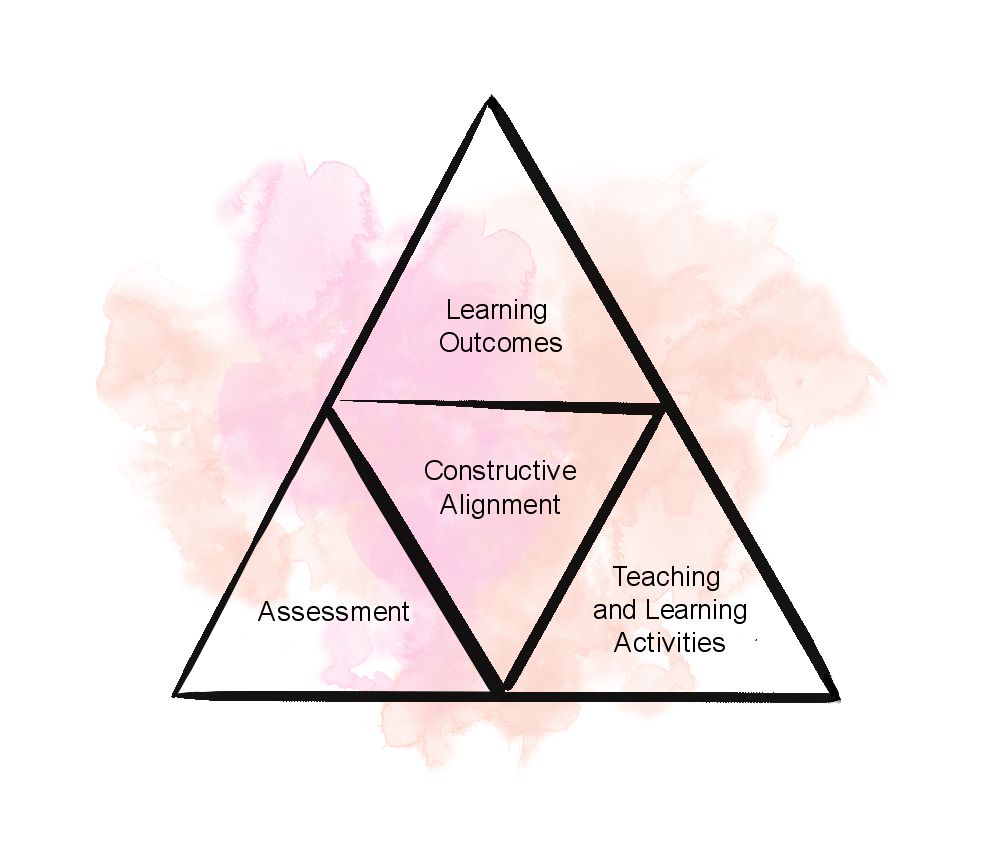What is Constructive Alignment?
Constructive Alignment is a teaching principle that combines constructivism, the idea that learners construct or create meaning out of learning activities and what they learn, and alignment, a curriculum design concept that emphasizes the importance of defining and achieving intended learning outcomes.
The goal of Constructive Alignment then, is to support students in developing as much meaning and learning as possible from a well designed, coherent, and aligned course. Courses are congruent and cohere in an explicit way when there is good fit and flow between a course’s intended learning outcomes, teaching and learning activities, and assessments of student learning.
As developed and defined by John Biggs (2014), Constructive Alignment involves:
- Thoughtfully determining intentions for what students should learn and how they will demonstrate their achievement of these intended learning outcomes, and clearly communicating these to students;
- Designing teaching and learning activities so that students are optimally engaged in achieving these learning outcomes; and
- Creating assessments that will allow students to demonstrate their attainment of the learning outcomes and allow instructors to discern how well these outcomes have been achieved.

Continue Your Learning
- Read more about the history, context, and use of Constructive Alignment in teaching and learning (Biggs, 2014).
- Gain a better understanding of outcomes based education with support from this narrated webinar (Goff, n.d.).
- Use this handout to develop or revise a set of learning outcomes for your course (British Columbia Institute of Technology Learning and Teaching Centre, 2010).
How does Constructive Alignment relate to Accessible Education?
Constructive Alignment supports positive academic outcomes for an increasingly diverse group of learners, because it makes teaching and learning goals and methods Aligned (well organized, consistent) and Explicit (obvious, visible).
Alignment of Values and Practice
The notion of Alignment can also encourage us to think about whether our intended values around accessibility and inclusion are aligned with and enacted in practice. In other words, how well are we ensuring that a lesson or course is constructed and facilitated in such a way that values identified on the syllabus and in discussion at the outset of the course are consistently carried into the classroom throughout the duration of the term. While not an obvious component of traditionally defined Constructive Alignment, this additional meaning of alignment is important to us in this FLEX Forward resource.
| As an example: If, during course design, we make the effort to include readings written by disabled people, but then lecture and/or class discussions speak only disparagingly about these authors, the intentions of valuing disabled people’s knowledges are undermined in practice. Instead of challenging ableism, ableism gets reinforced. The keyword of Alignment helps us pay attention for these forms of (in)congruence between values and practices. |
Implementing Constructive Alignment to Enhance Accessible Education: Alignment & Explicitness
In this resource, we incorporate Alignment and Explicitness as keywords and principles for moving Accessible Education forward, as will be explored further in subsequent modules.
HOW can we FLEX Forward to advance Accessible Education?
| Alignment |
|
| Explicitness |
|

Self-Reflection
- Which academic skills are essential to your learning outcomes or successful completion of your course? How will you explicitly identify these skills in your course outline and teach these skills to students?
- What significant skills, abilities, or knowledge do you hope/assume students have learned in other courses before arriving in your course? How might you check in with students to confirm whether this is the case and to provide additional instruction and resources for those new to these academic conventions?

Continue Your Learning
- Listen to Dr. Robert Fleisig discuss the importance of explicitly defining words and cultural conventions for the benefit of all students, and especially those for whom English is an additional language and for those unfamiliar with the Canadian education system.
.

CASE STUDY:
Enhancing Accessibility and Inclusion by
De-Mystifying the University
The university participates in an “institutional practice of mystery” (Lillis, 2001, p. 58) when implicit and unspoken academic conventions intimidate and create confusion and disadvantage for non-traditional students. As one example, university writing conventions can be difficult to articulate and name for those immersed in them, and extremely difficult to discern and understand for newcomers to the university. Unless academic conventions and skills are explicitly taught, the university will continue to exclude and undermine the participation of non-traditional students.
It is important for instructors to take efforts to de-mystify academic conventions for students, including commonly unnamed and untaught academic and disciplinary skills, like: critical thinking, proper referencing, scholarly writing, academic integrity, and discipline-specific vocabulary and genres of communication. Students benefit from explicit instruction and support, rather than being left to “read between the lines” or independently discover the “secrets” to succeeding at university through osmosis (Elton, 2010; Lillis, 2001).

